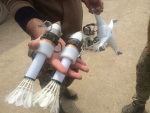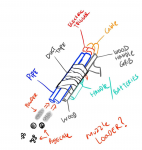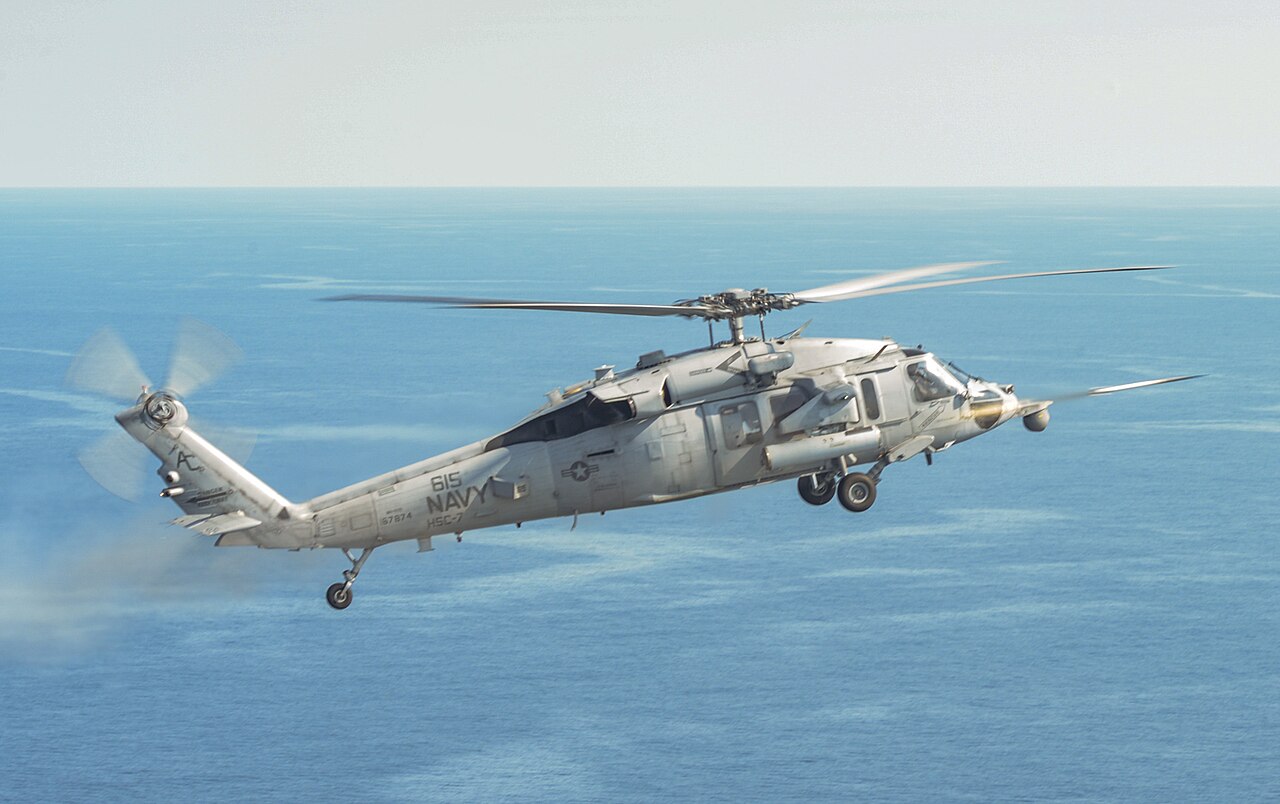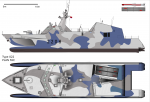As with your entire plan, you're showing extensive ignorance of how any of this works.
The Navy has eyes on every single civilian craft that gets within range to do something like launch a tactical anti-ship missile at them. They will know the ship's name, its class, and notice any odd things like massive racks of torpedos on the deck, especially when they start deploying them.
These are supposed to be deployed well outside of typical Exocet range. Like 300 kilometers away.
If you're using a ship big enough that these racks are not obvious, you're getting into the tens of millions of dollars price range, and probably tens of millions more for the concealed deployment mechanism. Also, sonar would immediately detect the torpedos once their engines are fired up anyways.
Isn't the max distance for sonar no more than about fifty kilometers?
This entire exercise is just 'you were thinking' with no actual testing to see what the practical requirements would be.
It was a back-of-the-napkin exercise. No, I didn't do engineering calculations for every little part of it.
If they're moving that slowly submerged, they won't even be able to creep up on the fleet, because the fleet will be moving faster even just at standard low-intensity patrol speeds.
Presumably, they would be deployed ahead of their targets (much like sea mines), not pursuing them from behind.
It's almost like you didn't do your research.
I estimated off the top of my head, based on outdated information. I had no idea prices were that ridiculous right now. In any case, like I said, I may have overestimated the length a bit. @Bear Ribs came up with a calc for surface area and volume that was much larger than what I was picturing.
If you make massive swarm attacks, it's a threat you have to treat seriously, instead of just lazily let them ram into you. That doesn't mean that they have a meaningful chance at actually taking you out when you are using appropriate tactics and weapons to deal with them.
This feels kind of weird. I mean, I feel almost personally attacked. Is the small speedboat threat real or not? Or is this one of those things where the Navy was like "Psych! We were just pretending to be weak! Muahahahaha!"
Boats which were only ever effective against forces conducting a land invasion of the place they were based out of. And of six thousand built, they managed to sink a few landing craft, and damage like three destroyers.
Not exactly effective knock-out weapons, and notably they were manned, and equipped with rockets.
Wait. Your calcs are assuming they deployed all 6,197 of them. It sounds to me like out of the 6,197 built, only a few hundred were actually sent at targets.
You're not accounting for the labor cost at all, which unless you're going to set up an expensive factory with lots of automation equipment, is going to be hundreds of man-hours worth.
If we're being reasonable, the labor would be in the area of $5k to $8k each, minimum.
Maybe <$10k is a little thin. $30k ought to do it, right?
...So you just assumed that they wouldn't use it in the Navy?
Why?
Cost? Toxicity? I don't know.
This isn't a matter of 'some.' This is a matter of 'probably a thirty to fifty percent failure rate,' unless you're employing highly skilled labor in the assembly, which again drastically jacks your cost up.
Ideally, that would be brought down to twenty percent by streamlining the design and standardizing the layout as much as possible.
Yes, there are people who are professional mechanics and/or engineers, who as personal passion projects, pour dozens to hundreds of hours and often thousands/tens of thousands of dollars into making such things. These are usually things they work on for years, building even more specialized skills on top of the specialized skills that they already possess.
And then, based on that, you're 'sure' (translation: you assumed) that it would be a trivial matter to build a much more sophisticated aircraft that uses one such engine as part of an integrated system that has a very low margin for error.
It's not that difficult to build a Gluhareff pressure jet with no moving parts and use it as the basis for a homemade cruise missile. All the plans are still widely available.
The key factor about light-weight racing quad-rotors is that they're lightweight. The primary way that they achieve high speed and performance is by having such a low mass that it's easy to do so.
This notably means that they have little to no payload, short endurance, relatively short range, and would be utterly incapable of resisting E-war counters, on top of being incredibly fragile.
I'm very certain one can compromise a little on the speed to give it a small payload, but yes, it would still be quite vulnerable to electronic warfare and high-precision AA gun fire with proximity-fused rounds.
Your entire supposition is apparently a long chain of 'I think just far enough about this to find data points and reference points that support what I want to be true,' and going no further. Even the designers for the Mark 14 torpedo did a better job than this.
If you want a solid idea, you have to pursue disconfirmation, IE find out what problems, complications, and failure states exist for your theory, and then actively try to disprove it to see how it actually stands up. You have failed to do this.
I honestly don't want to do detailed engineering drawings of something like this with structural bulkheads, measurements, and all that crap. If people want plans, they can draw them themselves. I ain't doing all the work just so the bad guys can take it and use it. I don't feel comfortable going into any more detail than I already have, in fact.
And also, you still haven't answered the question: "If this is so easy, why hasn't anyone else done it yet?"
My guess is that anyone with the will to do it has bigger budgets and real ASMs, so they don't need something built from scrap.
And your fishing boat carriers with their big obvious stacks of torpedoes on the deck aren't going to be hit by a missile or bomber at extreme range, well outside what these idiot drones can reach, because?
They'd be covered in tarps, or hidden in containers.
Okay, let's ignore that you apparently think there are so many identical working Cummins engines in good condition in junkyards you'll be able to outfit swarms of attack craft with them.
As usual, your estimates are absurd, more than absurd. A Mark 48 torpedo is 3600 pounds and 19 feet long, with 45 cubic feet of internal space. You're talking about building something lighter and only a bit larger than an existing torpedo, but with vastly longer ranges, a bigger (albeit stupidly inefficient and incapable) warhead, and far more advanced sensor abilities despite being built by cut-rate Campinos for 1/350th the cost of the Mark 48. Do you understand how ridiculous you're getting?
Mark 48 torpedoes run on monopropellant fuel. They don't use a snorkel to obtain oxidizer.
Your size to weight ratio is all screwed up so your ship won't be able to submerge in the first place. A hundred cubic feet of water weighs 6,242.80 pounds. You're approaching Weberfoam densities here. No, a 500 gallon ballast tank won't help, that's 66 cubic feet all by itself for just the water, a lot more for the tank and pumps, leaving perhaps at most 30 cubic feet for your warhead, engine, and electronics.
Oh gosh. I guess I wasn't clear about what I meant. ~100 cubic feet total internal volume, of which 66 cubic feet of empty space inside the hull is used as a ballast tank, 17 are used for the warhead, and the remainder is the fuel, engine, electronics, etc.
Wait. 13 cubic feet of fuel, and 3... oh shit, I just ran out.
See? This is really something that would take days of messing around before I arrived at anything like final numbers.
Okay, and the only time navy ships aren't going to be doing way more than that is when they're at anchor... even at lazy patrol speed they're going to be twice as fast and they can do four or five times your max speed at flank. How do you expect to even catch them, much less do your encircling maneuver to surround the ships?
Because they pump out the ballast, get up, plane, and hit 40 to 60 knots once they get within sonar range.
My dude, the engine you specified alone costs 9,995 dollars. That leaves 5 dollars for the hull, fuel and ballast tanks, explosives, all your advanced electronics, and the labor to assemble it. You truly haven't a clue what things cost.
I see one on eBay right now for $3k.
Realistically, any motor of equivalent power is fair game.
They concluded that in theory, the Iranian small boats could be a threat to troop landers or the like as they approached shore, not to any real naval group. That presumed the small boats were equipped with their own rockets and other weapons you don't have, not that Iranian boats were doing a measly 10 knots and could only do damage by ramming.
What you're trying to describe follows the laws of physics... and economics, less than a typical BattleTech design. I've never seen such FASAnomics proposed in real life before, my ghast is well and truly flabbered.
The figure you're coming up with wouldn't be enough to build a wood and papier-mache replica of your proposed attack boat, much less the real thing.
What I'm assuming is that things are being scavenged on the cheap. Seat-of-the-pants, MacGyver-style redneck engineering is being employed, wherever possible.
No calcs, no forethought. All trial and error, Beeman's chewing gum in the cracks like The Rocketeer, and a few fondlings of the ol' rosary beads. That oughta do it.
Try 100%. FFS, you're trying to mount a 215HP diesel engine onto thin sheet metal (you allocated zero dollars for structural members) and expecting it to not rip itself apart instantly. You don't even have any budget for bolts and rivets to hold things together.
The assumption was that structural members and fasteners would be included in that figure. Isn't a lot of this stuff cheaper in Latin America? What figure are we using here, for cost? Boutique steel from Anton's Steel Atelier in San Francisco, or Jose's Junkyard in Colombia?
Those guys aren't Campinos in South America working for 5 bucks an hour. Call up your dudes, ask them for a price estimate for your suicide boats and see what they say.
Oh, no. I know what they'd charge for it. It'd be like $40k to 80k in labor, minimum.
Yes it does, either your drones actually have that kind of longevity or your fishing boat haulers have to get so close to the carrier group they will be sunk before your failpedoes are ready to deploy.
They only have to last 200 hours, because the time from deployment to kaboom is less than 20 hours. They don't need a 2000+ hour MTBF.
Yes, Slaughterbots was nonsense that ignored the extremely large number of easy countermeasures available and all the numbers and facts on the ground in favor of a horror movie pretending to be realism. FFS, the killer 'bots in it could be completely defeated by closing the window. I'm not surprised such ridiculousness is inspiring you.
The vid literally showed bots (admittedly, CGI mock-ups) landing on the sides of buildings and acting both as motherships for smaller bots, and as breaching charges to punch holes in brick walls, bust out windows, et cetera.
As usual, the numbers aren't on your side. Your racing quadrotor is carrying no payload which would dramatically slow it. It was also likely in the range of around 10,000 dollars all by itself (Cue you explaining that it's mostly a few ounces of plastic and you found a cheap electric motor on Ali-Baba for 1.99 so a racing drone should be under five bucks because you don't understand how manufacturing or economics work).
$10k is for a very, very expensive camera ship. That page actually has a cost breakdown for a DIY quadrotor and it's like $500. I swear to god, it's just a carbon fiber frame with some motors, controller boards, and a battery attached on it. It's not ten grand.
The Terrorists meanwhile have a much better strategy than you. A Qassam rocket costs in the range of 300-800 dollars, its velocity is 5-10 times higher than even the racing drone, and the Israelis still shoot down 90% of them. For the price of your 100 grenade quadrotors they could fire around 1500 Qassams and land perhaps 150 hits. That's your actual quantity-over-quality weapon, at a 90% failure rate they would still land more hits than your entire drone fleet has members. With your quadrotors you're going to be spending around a million dollars on trying to send 100 of them at a target that can handle projectiles vastly faster, again it's going to be a lazy skeet shoot and then you're down a million bucks for no appreciable results.
- Surface-to-air countermeasure missiles can't shoot down quadrotors flying low to the ground.
- An exploding quadrotor isn't $10,000, it's no more than about $1000.
Last edited:








